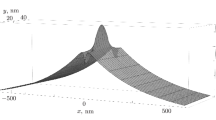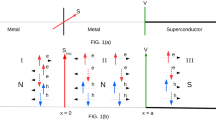Abstract
In the framework of the Bogoliubov–de Gennes equation, we study the spinless \(p\)-wave superconductor in an infinite strip in the presence of some impurity. We analytically determine the wave functions of stable bound states with energies close to edge points of the energy gap. We prove that for a small impurity potential, the contribution of the nearest subbands to the wave functions in the case of energy values close to edge points is very small, and these energy levels are significantly closer to the gap edge than in the one-dimensional case. We also study the bound states with nearly zero energy values; in contrast to the one-dimensional case, they do not have the “particle–hole” symmetry. In the cases under study, in addition to the bound states, there also exit resonance states related to them.
Similar content being viewed by others
References
J. Alicea, “New directions in the pursuit of Majorana fermions in solid state systems,” Rep. Progr. Phys., 75, 076501, 36 pp. (2012); arXiv: 1202.1293.
F. von Oppen, Y. Peng, and F. Pientka, “Topological superconducting phases in one dimension,” in: Topological Aspects of Condensed Matter Physics (École de Physique des Houches, Session CIII, 4–29 August, 2014, Lecture Notes of the Les Houches Summer School, Vol. 103, C. Chamon, M. O. Goerbig, R. Moessner, and L. F. Cugliandolo, eds.), Oxford Univ. Press, Oxford (2017), pp. 387–447.
M. Sato and S. Fujimoto, “Majorana fermions and topology in superconductors,” J. Phys. Soc. Japan, 85, 072001, 31 pp. (2016).
J. D. Sau, S. Tewari, R. M. Lutchyn, T. D. Stanescu, and S. Das Sarma, “Non-Abelian quantum order in spin-orbit-coupled semiconductors: Search for topological Majorana particles in solid-state systems,” Phys. Rev. B, 82, 214509, 26 pp. (2010); arXiv: 1006.2829.
Y. Oreg, G. Refael, and F. von Oppen, “Helical liquids and Majorana bound states in quantum wires,” Phys. Rev. Lett., 105, 177002 (2010).
V. Mourik, K. Zuo, S. M. Frolov, S. R. Plissard, E. P. A. M. Bakkers, and L. P. Kouwenhoven, “Signatures of Majorana fermions in hybrid superconductor-semiconductor nanowire devices,” Science, 336, 1003–1007 (2012); arXiv: 1204.2792.
A. Das, Y. Ronen, Y. Most, Y. Oreg, M. Heiblum, and H. Shtrikman, “Zero-bias peaks and splitting in an Al–InAs nanowire topological superconductor as a signature of Majorana fermions,” Nature Phys., 8, 887–895 (2012); arXiv: 1205.7073.
C.-X. Liu, J. D. Sau, T. D. Stanescu, and S. Das Sarma, “Andreev bound states versus Majorana bound states in quantum dot-nanowire-superconductor hybrid structures: Trivial versus topological zero-bias conductance peaks,” Phys. Rev. B, 96, 075161, 29 pp. (2017); arXiv: 1705.02035.
C. Moore, C. Zeng, T. D. Stanescu, and S. Tewari, “Quantized zero-bias conductance plateau in semiconductor-superconductor heterostructures without topological Majorana zero modes,” Phys. Rev. B, 98, 155314, 6 pp. (2018); arXiv: 1804.03164.
D. B. Woods, S. Das Sarma, and T. D. Stanescu, “Subband occupation in semiconductor-superconductor nanowires,” Phys. Rev. B, 101, 045405, 13 pp. (2020); arXiv: 1910.04362.
T. D. Stanescu, R. M. Lutchyn, and S. Das Sarma, “Majorana fermions in semiconductor nanowires, Majorana fermions in semiconductor nanowires,” Phys. Rev. B, 84, 144522, 29 pp. (2011); arXiv: 1106.3078.
F. Pientka, G. Kells, A. Romito, P. W. Brouwer, and F. von Oppen, “Enhanced zero-bias Majorana peak in the differential tunneling conductance of disordered multisubband quantum-wire/superconductor junctions,” Phys. Rev. Lett., 109, 227006, 5 pp. (2012); arXiv: 1206.0723.
B. D. Woods, J. Chen, S. M. Frolov, and T. D. Stanescu, “Zero-energy pinning of topologically trivial bound states in multiband semiconductor-superconductor nanowires,” Phys. Rev. B, 100, 125407, 17 pp. (2019); arXiv: 1902.02772.
Z. Hou and J. Klinovaja, “Zero-energy Andreev bound states in iron-based superconductor Fe(Te,Se),” arXiv: 2109.08200.
A. C. Potter and P. A. Lee, “Multichannel generalization of Kitaev’s Majorana end states and a practical route to realize them in thin films,” Phys. Rev. Lett., 105, 227003, 4 pp. (2010); arXiv: 1007.4569.
Yu. P. Chuburin and T. S. Tinyukova, “Mutual transition of Andreev and Majorana bound states in a superconducting gap,” Theoret. and Math. Phys., 205, 1666–1681 (2020).
Yu. P. Chuburin and T. S. Tinyukova, “Behaviour of Andreev states for topological phase transition,” Theoret. and Math. Phys., 208, 977–992 (2021).
R. Aguado, “Majorana quasiparticles in condensed matter,” Riv. Nuovo Cimento, 40, 523–593 (2017); arXiv: 1711.00011.
J. R. Taylor, Scattering Theory: The Quantum Theory on Nonrelativistic Collisions, John Wiley and Sons, New York (1972).
C. W. J. Beenakker, “Random-matrix theory of Majorana fermions and topological superconductors,” Rev. Modern Phys., 87, 1037–1066 (2015); arXiv: 1407.2131.
Funding
The work of Yu. P. Chuburin was supported by the financial program AAAA-A16-116021010082-8. This research was funded by the Ministry of Science and Higher Education of the Russian Federation in the framework of state assignment No. 075-01265-22-00 [1], project FEWS-2020-0010 [2].
Author information
Authors and Affiliations
Corresponding author
Ethics declarations
The authors declare no conflicts of interest.
Additional information
Translated from Teoreticheskaya i Matematicheskaya Fizika, 2022, Vol. 210, pp. 455-469 https://doi.org/10.4213/tmf10197.
Appendix
To determine the Green’s function of the Hamiltonian \(H^{(n)}\), we solve the equation
In what follows, we only consider the case \(n=\pm 1\) and use the assumption that \(\mu\) and \(O(1/l)\) are of the same order of magnitude. We obtain the Green’s function of the operators \(H^{(\pm 1)}\) near the edge points of the superconducting gap \((-|\mu|,|\mu|)\). By (A.7), we approximately have
For definiteness, we consider the case of a topological phase \(\mu >0\). For the energies \(E=\mu-\varepsilon\), where \(0<\varepsilon\ll \mu\), we have \(a=\Delta^2/2-\mu-{2\mu \varepsilon}/(\Delta^2)\). From (A.3), (A.6), and (A.8), we obtain
From this, by using the well-known relations
We now assume that \(|E|\ll \mu\). As above, we obtain \(\Psi^{(\pm 1)}=(H^{(\pm 1)}-E)^{-1}\Phi^{(\pm 1)}\), and in this case, we have
Rights and permissions
About this article
Cite this article
Chuburin, Y.P., Tinyukova, T.S. Interaction between subbands in a quasi-one-dimensional superconductor. Theor Math Phys 210, 398–410 (2022). https://doi.org/10.1134/S0040577922030102
Received:
Revised:
Accepted:
Published:
Issue Date:
DOI: https://doi.org/10.1134/S0040577922030102




